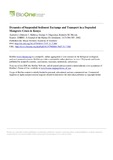Dynamics of Suspended Sediment Exchange and Transport in a Degraded Mangrove Creek in Kenya

View/
Date
2002Author
Kitheka, JU
Ongwenyi, GS
Mavuti, KM
Type
ArticleLanguage
enMetadata
Show full item recordAbstract
This study focuses on sediment exchange dynamics in
Mwache Creek, a shallow tidal mangrove wetland in
Kenya. The surface area of the creek is 17 km2
at high
water spring. The creek experiences semidiurnal tides with
tidal ranges of 3.2 m and 1.4 m during spring and neap
tides, respectively. The creek is ebb dominant in the
frontwater zone main channel and is flood dominant in the
backwater zone main channel. During rainy season, the
creek receives freshwater and terrigenous sediments from
the seasonal Mwache River. Heavy supply of terrigenous
sediments during the El Niño of 1997–1998 led to the huge
deposition of sediments (106
tonnes) in the wetland that
caused massive destruction of the mangrove forest in the
upper region. In this study, sea level, tidal discharges, tidal
current velocities, salinity, total suspended sediment
concentrations (TSSC) and particulate organic sediment
concentrations (POSC) measured in stations established
within the main channel and also within the mangrove
forests, were used to determine the dynamics of sediment
exchange between the frontwater and backwater zones of
the main channel including also the exchange with mangrove forests. The results showed that during wet seasons,
the high suspended sediment concentration associated
with river discharge and tidal resuspension of fine channelbed sediment accounts for the inflow of highly turbid water
into the degraded mangrove forest. Despite the degradation of the mangrove forest, sediment outflow from the
mangrove forest was considerably less than the inflow.
This caused a net trapping of sediment in the wetland. The
net import of the sediment dominated in spring tide during
both wet and dry season and during neap tide in the wet
season. However, as compared to heavily vegetated mangrove wetlands, the generally degraded Mwache Creek
mangrove wetland sediment trapping efficiency is low as
the average is about 30% for the highly degraded backwater zone mangrove forest and 65% in the moderately
degraded frontwater zone mangrove forest.
URI
: http://www.bioone.org/doi/full/10.1579/0044-7447-31.7.580http://erepository.uonbi.ac.ke:8080/xmlui/handle/123456789/23363
http://www.ncbi.nlm.nih.gov/pubmed/12572826
Citation
A Journal of the Human Environment, 31(7):580-587. 2002.Publisher
Royal Swedish Academy of Sciences Department of Zoology, University of Nairobi, Nairobi, Keny Ecology and Environment Research Programme, Kenya Marine and Fisheries Research Institute Department of Geography, University of Nairobi
